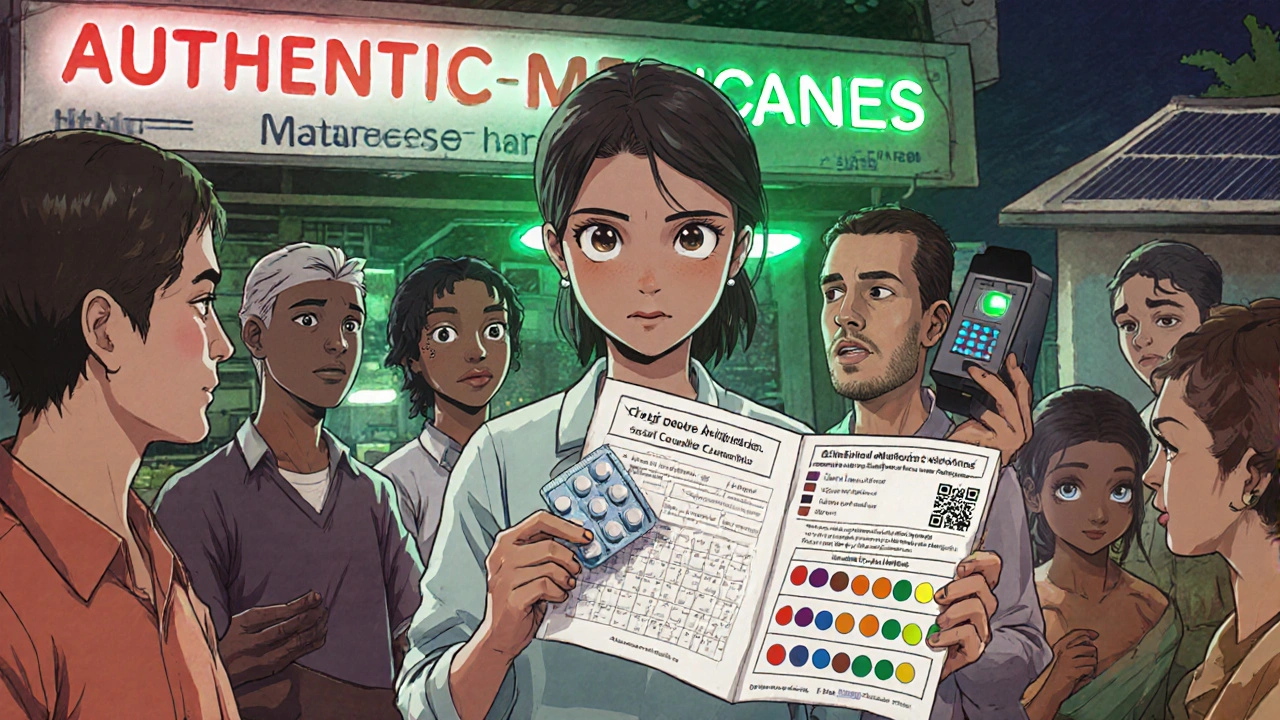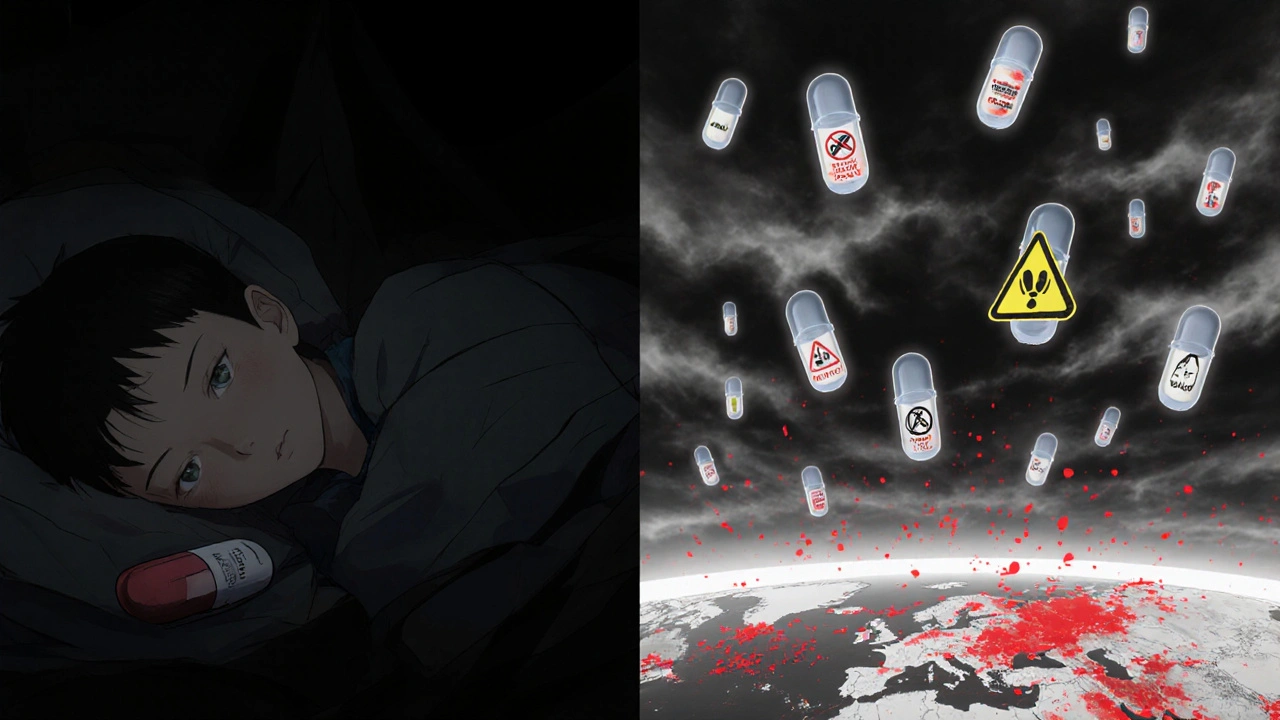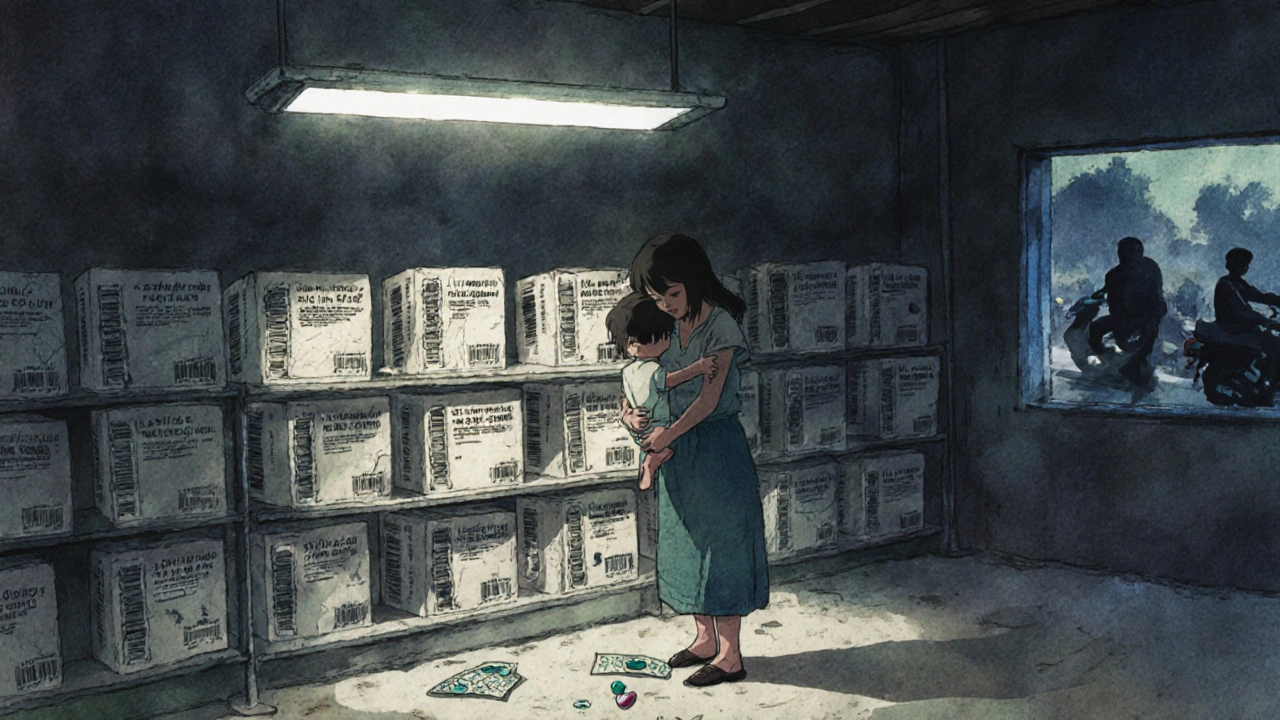Every year, tens of thousands of children in Africa, Asia, and Latin America die not from the disease they’re being treated for-but from the medicine meant to save them. These aren’t tragic accidents. They’re the result of a thriving criminal industry selling counterfeit drugs that look real but contain nothing-or worse, poison.
What Exactly Are Counterfeit Drugs?
Counterfeit drugs aren’t just cheap knockoffs. They’re dangerous fakes. The World Health Organization breaks them into two categories: substandard and falsified. Substandard medicines are real products that failed quality control-maybe they expired, were stored wrong, or have too little active ingredient. Falsified drugs are outright frauds: fake packaging, fake labels, fake ingredients. Some have no medicine at all. Others have the wrong dose. Some contain rat poison, antifreeze, or chalk.
In high-income countries, the chance of getting a fake drug is about 1%. In some parts of Africa and Southeast Asia, it’s over 30%. In certain border towns in West Africa, up to half of all antimalarial pills are counterfeit. And these aren’t just sold on shady street corners-they’re in pharmacies, hospitals, and online stores that look legitimate.
Why This Is a Global Health Emergency
The numbers are horrifying. In 2024, the Pharmaceutical Security Institute recorded over 6,400 incidents of counterfeit drug trafficking across 136 countries. That’s not just one bad batch. That’s a global network.
One of the deadliest impacts is on children. According to the OECD, counterfeit or substandard antibiotics and antimalarials contribute to between 72,000 and 169,000 child deaths from pneumonia each year. In sub-Saharan Africa alone, more than 116,000 people die annually from fake malaria drugs. That’s more than the population of a medium-sized city-every year.
It’s not just malaria. Cancer drugs, heart medications, and antibiotics are all targeted. In 2012, over 200 people died in Lahore, Pakistan after being given heart pills contaminated with a toxic chemical. In 2022, counterfeit cancer treatments were found across multiple countries, leaving patients with no hope and no explanation for why their treatment failed.
How Do These Fakes Get Into the System?
Counterfeit drugs don’t appear out of nowhere. They move through long, broken supply chains. A fake pill might start in a lab in China, then pass through five or seven middlemen before reaching a small clinic in rural Nigeria. Each stop is a chance for substitution, tampering, or mislabeling.
Why does this work? Because regulation is weak. Many developing nations lack the funding, staff, or technology to test medicines properly. Rural clinics don’t have labs. Pharmacists can’t tell the difference between a real and fake pill by sight. The packaging is often 90% identical-same colors, same fonts, same holograms. Even trained nurses can be fooled.
And the criminals are getting smarter. In 2024, Interpol reported that 35% of counterfeit drugs now include security features once reserved for real medicines-QR codes, tamper-proof seals, even 3D-printed blister packs. The goal? To look so real that no one questions them.

The Deadly Cost of Cheap Medicine
People buy fake drugs because they’re desperate. Legitimate medicines can cost 300% to 500% more than counterfeits. A real course of artemisinin-based antimalarials might cost $5. A fake one? $0.50. For a family living on $2 a day, the choice is clear-even if they’ve heard rumors about bad pills.
But the price isn’t just financial. It’s biological. A 2022 Lancet study found that 87% of counterfeit antibiotics contain too little active ingredient to kill an infection. That doesn’t just mean the patient doesn’t get better. It means the bacteria survive, adapt, and become resistant. This is how drug-resistant tuberculosis and malaria spread. And once that happens, even real drugs stop working.
Dr. Gottfried Hirnschall of the WHO put it bluntly: “Drug resistance caused by counterfeit medicines poses a very serious global health threat.”
Who’s Behind This?
It’s not lone street vendors. It’s organized crime. The profit margins are insane-up to 9,000% markup on some fake drugs. That’s more than human trafficking or drug smuggling. And the risk? Low. In many countries, selling fake medicine carries no jail time-or just a small fine. Meanwhile, the victims die quietly, often without anyone ever knowing why.
China produces 78% of the most sophisticated counterfeit drugs. Bangladesh, Lebanon, Syria, and Türkiye are major regional distributors. But the problem isn’t just where they’re made-it’s where they’re sold. In Southeast Asia, 50% of antimalarials in border markets are fake. In parts of West Africa, 18.7% of all medicines are substandard or falsified.
What’s Being Done?
Some solutions are working-but they’re not reaching everyone.
Blockchain verification systems, like the WHO’s Global Digital Health Verification Platform, let patients scan a code on the medicine to check its origin. Pfizer’s system has blocked over 302 million fake doses since 2004. In Ghana, the mPedigree SMS system lets people text a code from the pill pack and get an instant answer: real or fake. One user in Ghana said, “The SMS verification saved my child’s life.”
But here’s the catch: only 28% of people in low-literacy areas can use these systems without help. Many don’t have smartphones. Others can’t read. Electricity is unreliable. Solar-powered verification devices are being rolled out in 12 African countries, but they’re still rare.
Community health workers are making a difference. In pilot programs, training local volunteers to spot fake packaging and teach neighbors how to verify drugs reduced counterfeit use by 37%. Simple tools-like comparing pill color to a printed guide-can catch some fakes. But it’s not enough.

Why This Isn’t Getting Fixed
There are 76 countries that signed the Medicrime Convention, an international treaty to fight fake medicines. Only 45 have turned it into actual law. Enforcement is patchy. Border checks are inconsistent. Online pharmacies operate in the shadows, using cryptocurrency to avoid detection.
And the market is growing. The global counterfeit drug trade is worth $83 billion-and it’s growing at 12.3% a year. That’s more than double the growth rate of real pharmaceuticals. By 2027, it could hit $120 billion.
The UN Office on Drugs and Crime warns that proceeds from fake drugs often fund other crimes-arms trafficking, human smuggling, even terrorism. This isn’t just a health issue. It’s a security issue.
What Can Be Done?
Real change needs three things:
- Stronger regulation. Every country needs a national medicine authority with real power-to inspect, test, and punish. Right now, only 15% of low-income countries have 24/7 verification support.
- Accessible verification tools. SMS-based systems work. Simple visual checklists work. Solar-powered scanners work. But they need to be free, easy, and available everywhere.
- Public awareness. People need to know what fake drugs look like, where to report them, and how to verify. Social media campaigns, radio ads, and community meetings can save lives.
The EU has pledged €250 million to help 30 developing nations strengthen their supply chains by 2026. The WHO aims to cut counterfeit drug rates below 5% by 2027. But without global pressure, funding, and accountability, those goals won’t be met.
The Human Cost
Behind every statistic is a story. On Reddit, a man from Nigeria wrote: “My brother died of malaria last year after taking counterfeit Coartem. The pharmacy had no way to verify authenticity.” In Kenya, a nurse shared: “50% of our malaria test kits in rural clinics were fake. We didn’t know until patients kept getting worse.”
These aren’t abstract problems. They’re daily realities for millions. And until governments, drug companies, and international agencies treat this like the emergency it is, more people will die-not from disease, but from lies disguised as medicine.
Real medicine saves lives. Fake medicine kills. There’s no middle ground.
How can I tell if a medicine is fake?
It’s nearly impossible to tell by sight alone. Counterfeiters now copy packaging with 90% accuracy. The best way is to use a verification system-like an SMS code or app-if available. If not, buy only from licensed pharmacies or government health centers. Avoid online sellers unless you’re certain of their legitimacy. Look for tampered packaging, misspelled words, or pills that look different from previous batches.
Are counterfeit drugs only a problem in poor countries?
No. While 85% of counterfeit drug consumption happens in developing nations, fake medicines are found everywhere. The U.S. FDA reports about 1% of drugs are counterfeit, mostly from online pharmacies. But the scale and danger are far greater in countries with weak regulation. A fake pill in the U.S. might be ineffective. In a remote village in Malawi, it could be deadly.
Why don’t governments stop this?
Many lack the resources. Testing medicines requires labs, trained staff, and equipment-most rural clinics have none. Even when they do, corruption and lack of political will often prevent enforcement. Criminal networks are well-funded and mobile. Without international cooperation and funding, local agencies are outgunned.
Can I trust generic medicines from developing countries?
Yes-if they’re approved by a reputable regulator. Many generic drugs made in India, Bangladesh, or South Africa are safe, effective, and life-saving. The problem isn’t generics-it’s counterfeits. Always check if the manufacturer is licensed and the product is verified. Don’t assume all cheap drugs are fake, but always verify if possible.
What’s the most dangerous type of counterfeit drug?
Antibiotics and antimalarials are the deadliest. When they contain too little active ingredient, they don’t kill the infection-they teach the germs to resist treatment. This leads to drug-resistant strains that can spread across borders. A single fake malaria pill can contribute to a global health crisis. Cancer and heart drugs are also extremely dangerous because they’re used by vulnerable patients with no room for error.
Are there any success stories in fighting fake drugs?
Yes. Ghana’s mPedigree SMS system reduced counterfeit medicine use by 37% in pilot areas. In Senegal, community health workers trained to spot fake packaging cut fake drug sales in their regions by 40%. The WHO’s blockchain platform is now active in 27 countries with 99.9% accuracy. These show it’s possible-but only with sustained investment and local involvement.
How can I help?
If you’re in a developed country, support organizations working on global medicine safety-like the WHO, Medicines for Malaria Venture, or Global Health Security Initiative. Don’t buy medicine online from unknown sellers. Advocate for policies that fund medicine regulation in developing nations. And if you’re traveling, never buy medicine on the street-even if it’s cheap and looks real.


Graham Holborn
Hi, I'm Caspian Osterholm, a pharmaceutical expert with a passion for writing about medication and diseases. Through years of experience in the industry, I've developed a comprehensive understanding of various medications and their impact on health. I enjoy researching and sharing my knowledge with others, aiming to inform and educate people on the importance of pharmaceuticals in managing and treating different health conditions. My ultimate goal is to help people make informed decisions about their health and well-being.